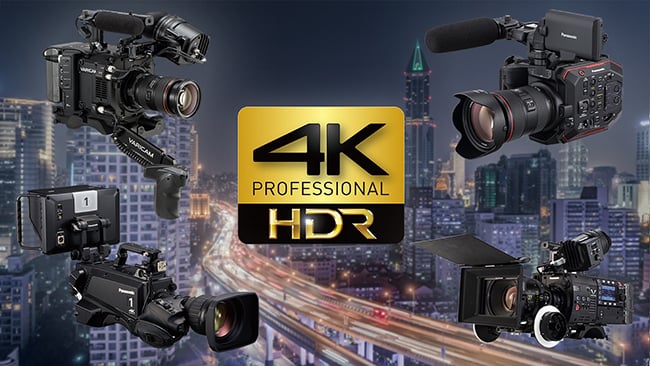

HDR need not be complicated thanks to these end-to-end HDR workflows from Panasonic.
The theory of HDR isn’t easy, and that applies to experts as well as beginners. The reason is that dynamic range is a domain that we don’t naturally think about - even though our eyes and our brains function within it. It’s a space that we don’t intuitively understand. It’s much too abstract.
Meanwhile, the results of well produced and encoded HDR are there for all to see. It is one of the biggest improvements in perceived video quality since the arrival of colour.
Our eyes are amazing
Our own, human, visual systems are able to cope with a truly massive dynamic range - maybe as much as 30 stops or more. That means we can see faint stars in the dead of night, and we’re not dazzled when the sun’s out. Standard Dynamic Range (SDR) for displays tops out at around 5 to 6 stops. That’s a huge mismatch with our own vision.
But our eyes are not perfect. We can’t see stars in daylight, even though they’re still there in the sky. We can’t see them because everything else is too bright. To understand HDR and the technology we employ to reproduce it, it’s important to take into account the way that our own perception works.
So how are we, mere biological systems, able to function in such an extraordinary wide range of lighting conditions? It’s because our retinas (which are essentially our “sensors”) have an incredibly wide dynamic range and a clever and a chemical “Automatic Gain Control” Meanwhile, our irises open and close compensate for widely different levels of illumination. It’s an incredibly effective system and we don’t even realise we’re doing it.
When you take this into account, the widest dynamic range we can accurately perceive within one scene is more in the region of 14 stops, and it is this spread between light and dark that most 10-bit HDR video systems try to encapsulate.

Panasonic caters for HDR across its range of professional cameras
HDR for live and scripted TV production
Exactly how HDR is handled depends on whether it’s a live or a “scripted” production. Let’s look at the latter first.
Cinematic cameras, like Panasonic’s VariCam and EVA1, or the studio cameras like the AK-UC3000, and the new AK-UC4000 have an inherent dynamic range capability that easily qualifies as HDR. Panasonic’s technical approach to HDR leads to a purer, more cinematic image with a natural look and feel, where the brightest highlights sit comfortably with detail in dark shadows.
Displaying HDR
Without necessarily realising it, we have been using HDR techniques ever since we’ve had large sensors with over 10 stops of DR. Capturing HDR isn’t the problem. Displaying it is.
So, until now, we’ve typically used Log Cinema and raw modes with our digital cameras to capture a wide dynamic range. And then what do we do? We compress it again, mapping extremes back into a narrower space, so that our limited dynamic range monitors can display it. Despite the apparent pointlessness of this, it does allow a cinematic-looking dynamic range to be shown on conventional monitors and the results can be pleasing, within the range of what we’re used to.
HDR gives a new degree of freedom to colourists
Now that HDR monitors are available, in essence, all we have to do is miss out that last stage where we compress the dynamic range again. This gives colourists much greater freedom, as they have a bigger dynamic range to work in. Typically, though, there will have to be a separate grade for HDR and SDR.
With live productions, there’s no time for a separate grading process. Pictures have to go out without delay. This does present issues with HDR.
Panasonic’s live cameras are easily capable of HDR performance, but it’s early days for HDR workflows in live productions. There are several schools of thought. One is that everything should be captured in log mode, which is then used as a Lingua Franca for switching and graphics. The signal is then adjusted for HDR and SDR outputs as necessary.
This works very well, but it does mean that the output for any individual camera is not usable: not even for monitoring.
Hybrid Log Gamma
Panasonic has developed an effective solution to this problem. The company has chosen to work with the BBC/NHK framework for HDR called Hybrid Log Gamma (HLG). This differs fundamentally from the other common alternative, PQ (Perceptual Quantisation) in that HLG refers solely to the original scene. It does not need to “know” anything about the display.
That’s because HLG will work - without modification or setting up - with most types of display, SDR or HDR. (PQ is “Display Referenced”, meaning that in order to grade it accurately, the colourist must have some knowledge of the targeted display).
In this sense, HLG is intrinsically more flexible.
HLG, on its own, does not solve all the issues of simultaneous HDR/SDR broadcasting and there are times when either the video content can look too light or two dark in either HDR or SDR when exposed for the other HDR delivery medium.
An elegant answer
Panasonic’s answer to this is elegant.
First, Panasonic’s HDR-capable broadcast cameras split their outputs into SDR and HDR, where HDR is presented through the medium of HLG. Then, depending on the nature of the scene and the dynamic range needed to reproduce it, Panasonic adds an “offset” to the image, designed to optimise viewing both in SDR and HDR for that particular scene. With the necessary offset established for the scene you can expose in HDR or SDR and be assured that the other mode will also be properly exposed.
Even when working in HDR, it’s rarely necessary to use the entire range from light to dark. Panasonic’s ability to add this offset means that for the majority of scenes, it will be possible to watch a high quality HDR version and a very acceptable SDR version at the same time, from the same video source.
For those working in the more established post-graded content environment; Panasonic’s VariCams, acquire native wide dynamic range V-Log imagery. This V-Log content is easily graded to provide superb content for HDR10, or any other variants of the “PQ” family. HLG may be the best choice for live; whereas “PQ” may be more suited for delivered graded content.
Panasonic’s pragmatic, flexible approach to HDR means that there is a simple, easy to understand and easy to watch methodology for creating and displaying high quality HDR content - whether it’s live or pre-recorded.
For more information visit (US) and (Europe).
Title image courtesy of Shutterstock.
Tags: Production


Comments